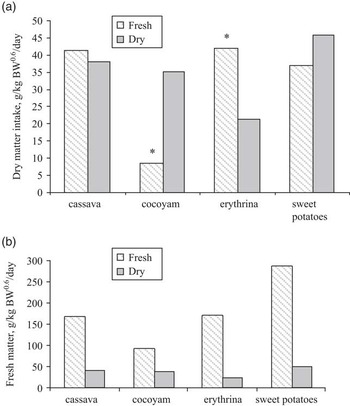Introduction In the tropics, the integrated farming systems are mainly based on a close association between local breeds and local feed resources. Among these resources, tropical foliages potentially have a high biomass yield and could partially cover the one part of the protein requirements of a pig. The major constraints of these local feed resources could be their high fibre contents which reduced the ingestibility and the digestive utilization of the diet. The present work aimed at determining the palatability of four tropical foliages (cassava Manihot esculenta Crantz, sweet potatoes Ipomoae batatas, erythrina Erythrina esculenta and cocoyam Colocasia esculenta) in the Creole pig.
Material and methods Two experiments were carried out to investigate the palatability of tropical foliages (cassava, wild cocoyam, erythrina and sweet potatoes) in growing pigs. In Experiment 1, the impact of the incorporated rate of tropical foliages (0, 5, 20, and 35% in DM offered) was tested on voluntary feed intake in four Latin 4 × 4 square designs. All the experimental diets were formulated to be isonitrogenous (14.5% crude protein, CP) and to have the same metabolizable energy content (11.5 MJ ME/kg DM). The diet without foliage was formulated with corn, soybean meal and wheat bran. In the diets including 5, 20 or 35% of the experimental raw materials, the amount of wheat bran was reduced and the energy content was maintained constant when supplementing with vegetal oil. Pigs were fed ad libitum and had free access to water. In experiment 2, the effects of the processing form (fresh vs. sun dried) of cassava, wild cocoyam, erythrina and sweet potatoe foliages on voluntary feed intake were tested in 2 simultaneous 4*4 Latin square designs. Practically, in a first meal, pigs received 90 g/d/kg BW0.60 of a commercial corn soybean meal diet (CSBM) (18% CP, 15.4 MJ/kg ME) and thereafter, pigs were fed 45 g/d/kg BW0.60 of dry leaf meal or the fresh leaves. The leaf meal was mixed with equal amounts of water.
Results The results obtained in the first experiment (table 1) show a significant difference according to the type of leaf and the incorporation rate (P < 0.001).
Table 1 Mean values for daily consumption (g dry matter/kg BW0.6/day) in pigs fed with different incorporation rates of cassava leaves, cocoyam leaves, erythrina leaves and sweet potatoes leaves with a basal diet (experiment 1)

With a, b, c Least squares mean values within a row with unlike superscript letters were significantly different between diets, P < 0.05.
The increase of foliage incorporation rate did not affect the DM intake for sweet potatoes and cocoyam; in contrast the DM intake decreased when the incorporation rate of cassava and erythrina leaves increased. These differences could be explained by differences in chemical composition (fibre content). At 35% incorporation rate, the highest ingestibility was measured for sweet potatoes and the lowest for erythrina; Intermediate values were found for cassava and cocoyam.
On a DM basis, the presentation form influenced palatability of leaves only for cocoyam and erythrina. When fresh materials were fed to the pigs, the ingestion significantly decreased from 70% in cocoyam (P < 0.05) and increased from 50% for erythrina (P > 0.05) (Figure 1a). On a fresh basis, the best ingested material was the sweet potatoe foliages followed by the cassava and erythrina foliages (Figure 1b).

Figure 1a and b Mean values for voluntary feed intake of different leaves in growing pigs according to form of the distribution (fresh vs. dry meal).
Conclusion According to our results, the palatability of tropical forages changes according to the plant species. These differences were probably related to differences in dietary fibre content and in secondary metabolites. Sweet potatoes appear to be the most suitable to be used as a fresh forage meal in pigs. The low palatability of fresh cocoyam leaves was probably related to the presence of oxalic acid. For sweet potatoes, cassava and erythrina leaves, the drying process did not improve their palatability. These results suggest that sweet potatoes, cassava and erythrina leaves could be given to pigs without any treatment to partly or completely cover their protein requirements.






